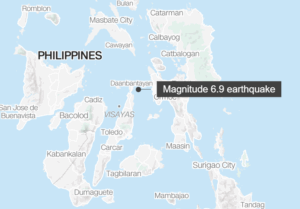MANILA – A magnitude 6.9 earthquake struck late Tuesday near the central Philippine coast, triggering structural collapse, fires and multiple casualties. The U.S. Geological Survey (USGS) located the quake roughly 10 km below sea level, just west of Palompon and close to Bogo in Cebu province.
Local reports confirm at least five people died, including a child and several first responders, when a sports complex collapsed during a basketball game in the town of San Remigio.
Red Cross teams treated dozens of injured across multiple provinces, while emergency services scrambled to mobilize rescue efforts in darkness and amid continuing aftershocks.
Damage, chaos and local response
In Cebu province, images and eyewitness videos circulated on social media capturing the dramatic aftermath:
- A mall caught fire, a McDonald’s restaurant suffered severe damage, and beauty pageant contestants were seen fleeing the stage mid-event.
- Partial collapses and extensive cracking were reported in churches, schools and municipal buildings, prompting evacuations.
- Power outages, disrupted water systems and blocked roads complicated relief work.
Cebu Governor Pam Baricuatro took to social media to urge calm and assured residents that aid would arrive swiftly. The municipality of Medellin also announced suspension of classes and work until structural safety assessments were completed.
Aftershocks, tsunami fears and geological setting
Multiple aftershocks were recorded in the hours following the main quake, prompting initial tsunami warnings for Cebu, Leyte and Biliran provinces—though those alerts were later canceled by the Philippine Institute of Volcanology and Seismology (PHIVOLCS).
At the same time, a minor eruption of Taal Volcano, located about 70 km south of Manila, emitted a plume rising 2,500 meters. PHIVOLCS maintained its alert level at Level 1, indicating low risk.
The Philippines sits on the Pacific Ring of Fire, a vast arc of seismic activity that contributes to frequent earthquakes and volcanic eruptions.
Broad impact and historical context
The tremor was strongly felt by over half a million people across the Visayas archipelago, including in Cebu, Biliran and Leyte provinces.
According to USGS models, a quake of this magnitude and depth can inflict “considerable damage in poorly built structures” and “slight to moderate damage in well-built ordinary structures.”
In historical perspective, the Philippines has experienced several deadly earthquakes in recent years. In 2022, a magnitude 7.0 quake in northern Luzon killed at least five people. In 2019, a 6.1-magnitude quake in Luzon cost 11 lives.
Structural safety inspections are underway
Rescue operations remain challenging after dark, and authorities are racing to reach remote mountain communities where road access has been severed.
Structural safety inspections are underway in schools, hospitals and public buildings. Suspension of classes and government work is in force until these assessments are complete.
Officials have urged vigilance amid the possibility of further aftershocks. With the initial tsunami alerts lifted, attention now shifts to securing relief supplies, restoring utility services, and stabilizing communities already shaken by the disaster. (zai)

